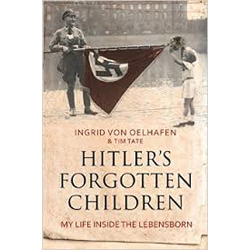 Published: 2015
Published: 2015
Author: Ingrid van Oelhofen and Tim Tate
Honest and moving account of Nazi persecution – a must read

The Nazi obsession with racial purity is well known; their goal of an Aryan master race and subsequent racial policies led to the murder of 6 million Jews in the Holocaust and the targeting of other racial and religious groups including Black Germans, gypsies, and physically and mentally disabled people. Millions of untermenschen (sub-humans) were killed, sterilised or imprisoned. Much of this is very well documented and is becoming increasingly widely known. What is less well known, however, were other attempts to create racial cleanliness. In her memoir Hitler’s Forgotten Children: My Life Inside the Lebensborn, Ingrid Von Oelhafen recounts her story of discovering that she had been taken from her Yugoslavian parents as a toddler and fostered by a German family.
As a child Ingrid felt little connection with and affection from her family with her “mother” abandoning her and her “brother” in a children’s home following their escape from the Soviet occupied areas of post-war Germany. After the end of the Cold War, Ingrid begins to discover the horrific truth about her own identity and more about the Lebensborn programme which saw the SS attempt to ensure the dominance of the Aryan race by encouraging suitable women and SS officers to have children. When this plan proved to be ineffective the programme extended to include the kidnapping of children deemed to have the appropriate genetic make-up from their families in occupied countries and gifting them to good German (Nazi) couples. Ingrid’s investigations lead her to her birth family and to other victims of the Lebensborn programme.
I regard myself as having a fair degree of knowledge about the Nazi period and the racial policies which led to so many deaths. My previous work introduced me to lesser known crimes such as the T4 Aktion, which saw at least 70,000 disabled adults and children murdered and the attacks on lesbian and gay people under the Third Reich, however despite my experiences I had not heard of the Lebensborn programme until reading this book. It seems almost unbelievable that we are still uncovering and learning about the atrocities committed in Europe which are continuing to affect the lives of innocent victims 75 years on.
Hitler’s Forgotten Children is a shocking book, partly because it’s the story of just one person. We get to know Ingrid and her life, feel her pain and follow her quest for the truth. As with some of the best depictions of historical events, this book works so well because it focuses on the human impact of political decisions. We see exactly how Ingrid’s lack of identity has impacted her life and she shares a number of short anecdotes which illustrate how other people have been affected by their experiences as Lebensborn children.
I was left angry and sad at the situation Ingrid had found herself in, and the bureaucracy and secrecy that stopped her discovering the truth for so long. I had to take some quiet time after reading it just to process what I had learned. This is a hugely important book which anyone with an interest in the Third Reich, or who cares about the damaging impact of supremacist politics, must read. I hope that Ingrid can find some peace now that she finally knows her life story.
